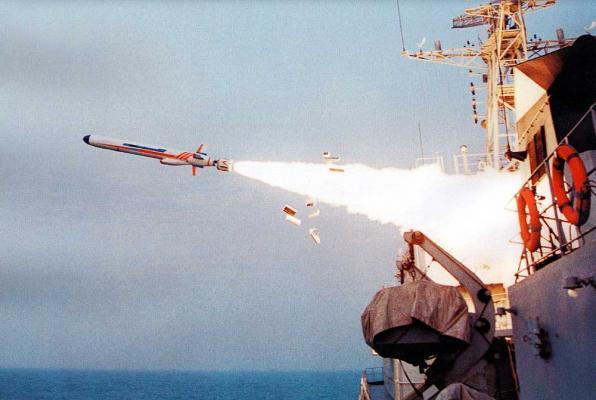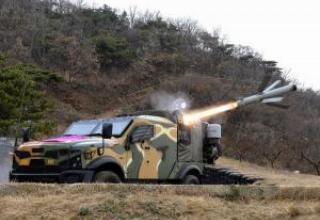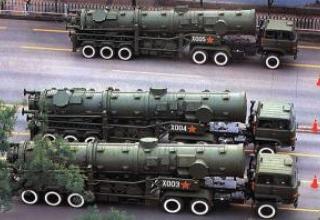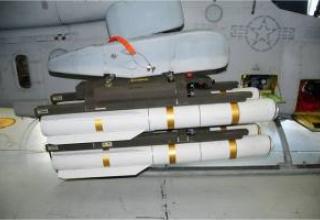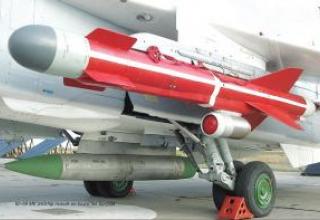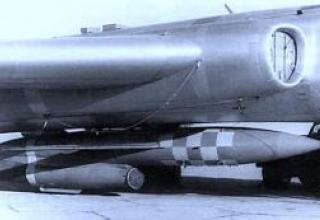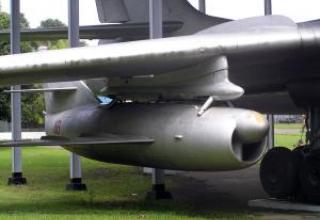The long-range anti-ship cruise missile YJ-62 ("Attack Eagle" Yingji-62, export designation - C-602) is designed to engage surface ships of all classes and types, both single and as part of a group, in conditions of electronic and fire counteraction of the enemy. The missile can be placed on various carriers and used day and night, in any weather conditions, alone and in a salvo including ground targets.
YJ-62 is developed by China Aerospace Science and Industry Corporation (Third Aerospace Academy). It entered service with the Chinese Navy in 2004, and the first carrier was a Project 052C destroyer (Lanzhou) with Flight Number 170 (see photo). Later on, on the basis of the YJ-62 missile was developed coastal complex, deployed work on the aircraft version of the missile to arm the Chinese advanced bomber H-6K Xian and submarine missiles.
The missile was authorized for export by the Chinese Government in 2005 under the designation C-602, and the range of the export version was reduced to 280 kilometres in order to comply with international agreements. The C-602 was first demonstrated in 2006 at the sixth annual air show in Zhuhai and has since been repeatedly presented at international arms exhibitions. In 2009 the C-602 was demonstrated for the first time at the sixth annual air show in Zhuhai and was repeatedly presented at international arms exhibitions. In 2009, 120 C-602 missiles entered service with Pakistani Navy, which plan to use them as a counterbalance to BrahMos missile of Indian surface ships.
In June 2008, 120 C-602s were delivered to the Pakistani Navy as a counterbalance to BrahMos surface ships of India. China People's Liberation Army Navy adopted a new version of YJ-62 missile with extended range, designated YJ-62C. According to the reports of the Chinese Navy Command, 120 YJ-62C missiles entered service with the coastal defense units of the Fujian Naval Base (Eastern Fleet).
According to experts, in the development of YJ-62 were used technology and components of Tomahawk missile received from Afghanistan and Iraq, as well as Soviet X-55 missiles purchased through Ukraine. Translated with www.DeepL.com/Translator (free version)
Composition:
The YJ-62 missile (see photo) is an airplane designed with a cylindrical body with an ogival head-end fairing, a folding wing in the central part of the body (see photo) and a folding cross-shaped stabilizer (see photo) in the tail. The missile is equipped with a small-size turbofan engine WS-500. The engine weighs about 200 kg, thrust is 510 kgf. The trapezoidal air intake is located in the lower part of the hull (see photo). In the ship and ground versions, a single-chamber solid propellant launch engine is mounted on the rocket, located in tandem with the march.
YJ-62 can be equipped with various combat units. The anti-ship version has a high-explosive 300ct penetration-type combat unit with an electronic fuse.
The YJ-62 control system includes an active radar homing head (ARGHS), inertial platformless navigation system, radio altimeter and power supply unit. In the marching section of the trajectory, the missile is guided by an inertial system. For the YJ-62 missile, the inertial control system is complemented by a GLONASS satellite navigation receiver and China's Compass national satellite positioning system, and the C-602 export version uses a GPS receiver. Currently, Compass covers only Asia and part of the Pacific, but its global deployment is planned in about five years. The homing head is able to quickly change the frequency of radiation by arbitrary law in order to increase noise immunity under radio electronic countermeasures. Range of detection of a typical target of ARGSN is 40 km, range of capture for escort is 30 km, sector of vision ± 40°. Some sources claim that ARGSN YJ-62 is copied from Italian radar Grifo-7, which was used to upgrade multi-purpose F-7PG aircraft of Pakistani Air Force.
According to unconfirmed reports, the YJ-62 can be equipped with a data line, receive target designation from aircraft and radar reconnaissance helicopters and can be redirected in flight to other targets.
The maximum speed of the missile is more than 0.9M, but when flying over rough terrain it is significantly reduced. The flight height above the ground is up to 30m, above the sea - up to 10m, firing range is 400km. In the homing area, the missile drops to 7m above sea level. The combat application is provided at sea disturbance up to 6 points, wind speed up to 20m/s and ambient temperature from -30° to +60°С.
At present YJ-62 is used as a part of coastal complexes and is also placed on surface ships. On the project 052C destroyer, the missiles are placed in two four-container deck-type launchers in the middle part of the ship (see photo).
The shore-based launcher is mounted on a modified chassis of an all-terrain truck with an 8x8 wheel arrangement and a payload of 22 tons (see photo). A package of three transport and launch containers with YJ-62 missiles is installed on the PU. The typical battery of the coastal complex includes four PU, battery command post, transport and charging machines and support vehicles. Translated with www.DeepL.com/Translator (free version)
Characteristics:
| Range of fire, km | 40 - 400 (280 for C-602) |
| Flight speed, M. | 0.6-0.9 |
| Height of flight over the sea, m | 7-10 |
| Flight height above ground, m | 30 |
| Dimensions, m: - length (without starting accelerator) - booster length - diameter - wingspan |
6.1 7.0 0.540 2.9 |
| Starter weight, kg | 1350 |
| Start accelerator weight, kg | 210 |
| Weight of combat unit, kg | 300 |
Testing:
Flash tests were conducted in August-September 1960. The first stage of the flight and design tests included 10 launches from a flooded PSA stand in Balaklava. The first launch of the Amethyst cruise missile from underwater position was made on June 24, 1961. Two more launches were made by the end of the year. In 1963-1964 at the plant № 444 submarine S-229 was converted under the project 61ZAD in the carrier rocket "Amethyst". In July-December 1964 from the submarine S-229 launched 6 missiles, 3 of which had a direct hit on the target, and 2 launches were unsuccessful.
The phase of joint tests was held in the Black Sea on the submarine project 61ZA from March 1965 to September 1966. A total of 13 launches were made and the tests were "mostly successful". In October-November 1967, Amethyst flight tests were conducted in the Northern Fleet from project 670A submarine. A total of 10 launches were made. Of these, 2 were single launches, 2 by a two-missile volley and 1 by a four-missile volley.
The submarine K-43 was in the Indian Navy from January 1988 to 1991, having spent about a year in autonomous voyages. All training missile firing ended in a direct hit to the target. On January 5, 1991, the boat's lease expired. On 5 January 1991, the boat's lease expired. India worked hard to extend the lease and even purchase a boat of the same type. However, under U.S. pressure, the Russian leadership abandoned plans to sell nuclear-powered submarines.
Sources:
- Precision Guided Munitions in the Region www.ausairpower.net YJ-62
- www.deagel.com

